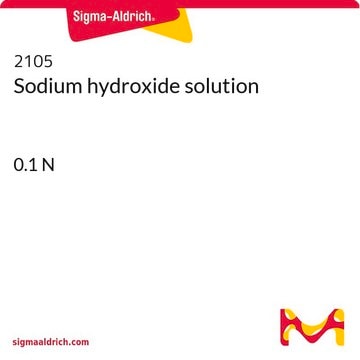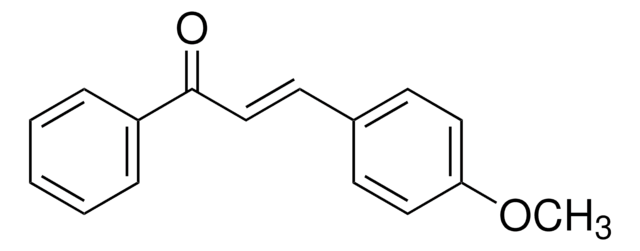1.60309
Sodium hydroxide solution
c(NaOH) =0.01 mol/l (0.01 N), Titripur®, Reag. USP
Sinónimos:
Sodium hydroxide solution
About This Item
Productos recomendados
product name
Hidróxido de sodio solution, 0.01 M NaOH (0.01 N), Titripur®, reag. USP
Agency
reag. USP
Nivel de calidad
presión de vapor
3 mmHg ( 37 °C)
Línea del producto
Titripur®
formulario
liquid
calidad
Analyzed in our ISO 17025 accredited QC lab
idoneidad de la reacción
reaction type: Acid-base reactions
envase
Titripac® of
concentración
0.01 M NaOH (0.01 N)
técnicas
titration: suitable
temp. de almacenamiento
15-25°C
cadena SMILES
[OH-].[Na+]
InChI
1S/Na.H2O/h;1H2/q+1;/p-1
Clave InChI
HEMHJVSKTPXQMS-UHFFFAOYSA-M
¿Está buscando productos similares? Visita Guía de comparación de productos
Categorías relacionadas
Aplicación
- Improvement of durability and drying shrinkage of sodium carbonate activated slag through the incorporation of calcium hydroxide and sodium hydroxide.: This study investigates the effects of incorporating sodium hydroxide and calcium hydroxide into sodium carbonate activated slag. The results show significant improvements in the durability and drying shrinkage properties of the material, making it a viable option for construction applications where enhanced performance is required (Construction and Building Materials, 2020).
- Effect of Sodium Silicate to Hydroxide Ratio and Sodium Hydroxide Concentration on the Physico-Mechanical Properties of Geopolymer Binders.: This study investigates the influence of the sodium silicate to sodium hydroxide ratio and the concentration of sodium hydroxide on the mechanical properties of metakaolin-based geopolymer binders. The results indicate that both the ratio and concentration significantly affect the compressive and flexural strength of the binders, providing valuable insights for optimizing geopolymer formulations (East African Journal of Engineering, 2023).
- Effect of Sodium Hydroxide, Liquid Sodium Silicate, Calcium Hydroxide, and Slag on the Mechanical Properties and Mineral Crystal Structure Evolution of Polymer Materials.: This research examines the roles of sodium hydroxide, liquid sodium silicate, calcium hydroxide, and slag in the development of mechanical properties and mineral crystal structures in polymer materials. The study reveals that sodium hydroxide is essential for creating a strongly alkaline environment that promotes the formation of beneficial mineral crystals, thereby enhancing the compressive strength of the materials (Crystals, 2021).
- Effects of Sodium Hydroxide and Calcium Hydroxide on the Phase Equilibria of Methane Hydrates.: This study explores the impact of sodium hydroxide and calcium hydroxide on the phase equilibria of methane hydrates. The findings provide insights into how these compounds influence hydrate stability and formation, which is critical for applications in natural gas storage and transportation (SSRN Electronic Journal, 2022).
Características y beneficios
This volumetric solution is analyzed by our calibration laboratory D-K-15185-01-00 which is accredited according to DIN EN ISO/IEC 17025 for analysis of amount-of-substance concentrations in volumetric solutions by DAkkS (Deutsche Akkreditierungsstelle - German National Accreditation Body). The accreditation certificate can be found at www.sigmaaldrich.com/ISO17025.
Envase
Nota de análisis
Amount-of-substance concentration 0.00995 - 0.01005 mol/L
Measurement uncertainty ± 0.00003 mol/L
Traceability NIST SRM
The concentration is determined by volumetric titration and refers to 20°C.
The amount-of-substance concentration of this volumetric solution is determined with standardized hydrochloric acid solution (article number 1.09060). The hydrochloric acid solution is standardized and traceable to a primary standard reference material (SRM) from the National Institute of Standards and Technology, Gaithersburg, USA (NIST SRM 723 Tris(hydroxymethyl)aminomethane) by means of volumetric standard Tris(hydroxymethyl)aminomethane (article number 1.02408), certified reference material according to ISO 17034, analyzed by our accredited calibration laboratory of Merck KGaA, Darmstadt, Germany according to DIN EN ISO/IEC 17025. The uncertainty is expressed as expanded measurement uncertainty with a coverage factor k=2 covering a confidence level of 95%.
Note: The titer is a correction factor to correct for variations of the volumetric solution, the titration equipment, the temperature and other laboratory conditions. For correct titration results it is recommended to determine a titer with the laboratory specific equipment and under laboratory specific conditions directly after opening a new bottle and at regular time intervals.
Información legal
Producto relacionado
Código de clase de almacenamiento
12 - Non Combustible Liquids
Clase de riesgo para el agua (WGK)
nwg
Punto de inflamabilidad (°F)
Not applicable
Punto de inflamabilidad (°C)
Not applicable
Certificados de análisis (COA)
Busque Certificados de análisis (COA) introduciendo el número de lote del producto. Los números de lote se encuentran en la etiqueta del producto después de las palabras «Lot» o «Batch»
¿Ya tiene este producto?
Encuentre la documentación para los productos que ha comprado recientemente en la Biblioteca de documentos.
Los clientes también vieron
Nuestro equipo de científicos tiene experiencia en todas las áreas de investigación: Ciencias de la vida, Ciencia de los materiales, Síntesis química, Cromatografía, Analítica y muchas otras.
Póngase en contacto con el Servicio técnico




